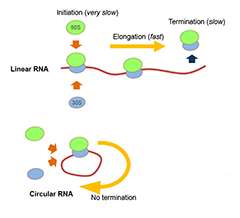Producing protein from circular RNA in E.Coli

Circular RNAs were recently shown to be abundant in mice and humans where they influence gene expression.
In a study published today in the journal Angewandte Chemie, the team, led by Dr Hiroshi Abe report that circular RNA strands treated with the E. coli cell-free system can be translated to produce 100 times more protein than their linear counterparts.
"The translation process is a lot more efficient on circular RNAs than on linear templates because the speed of the re-initiation process is greatly increased," explains Dr. Abe.
This new technique could be used for the synthesis of tandem-repeat peptides such as those found in biologically important proteins such as silk, collagen and epidermal growth factor.
More information: Abe, N. et al. Rolling circle amplification in a prokaryotic translation system using small circular RNA, Angewandte Chemie International Edition, 2013
Journal information: Angewandte Chemie , Angewandte Chemie International Edition
Provided by RIKEN
















